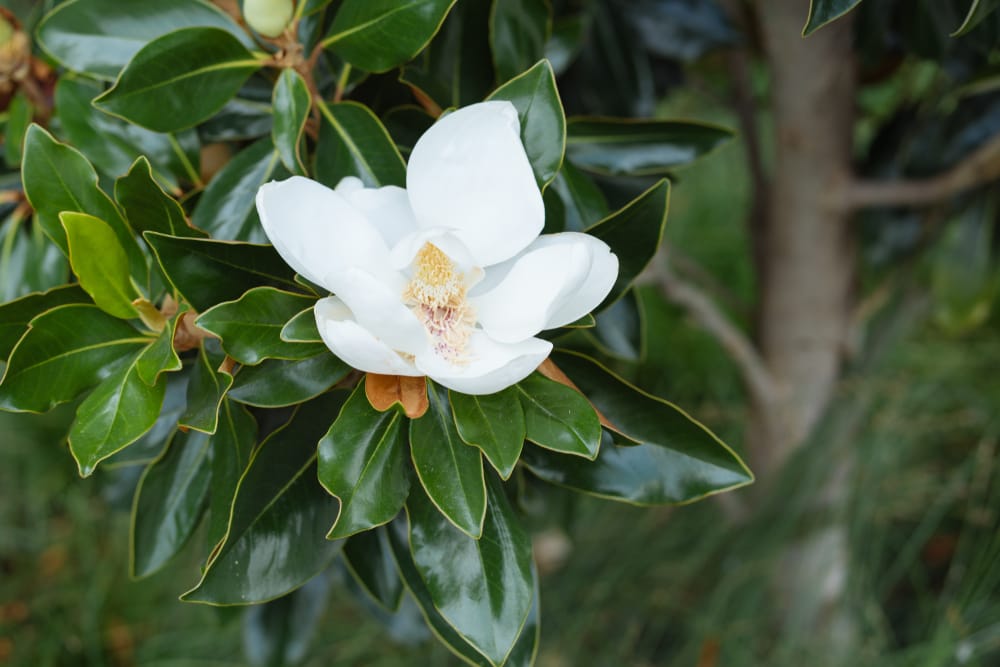
Magnolia Care
Southern Magnolias are planted for their shade and their evergreen foliage. There are deciduous Magnolias that lose their leaves in the winter and have large, usually purple or pink flowers. There are some new yellow blooming Magnolias but they are a rare find in this area. The ones that lose their leaves are usually planted for their flowers. Magnolias generally have few issues that will be fatal. Maybe unsightly, but not fatal. Their bark is thin, so they are prone to winter freeze damage and bark cracking. Scale often attack leaves and stems. Both hard and soft scale tend to attack them. The scale insects are not fatal, but they produce honeydew which brings black sooty mold growth, which makes the tree unsightly and blocks chlorophyll.
Another pest that likes to attack Magnolias is Sapsuckers. Sapsuckers are birds like woodpeckers that drill into the bark making a line of holes in the tree. When Sapsucker damage is extreme water flow to through the tree is reduced weakening it. Each hole is an open wound for disease and insects to get inside the tree. Occasionally leaf miners will harbor in leaves, but this is usually minor damage and only damages the leaves. They will look like squiggly lines on the leaves. Magnolias could be attacked by many diseases but the hot dry North Texas weather keeps most of the diseases from becoming an issue. The main Magnolia disease seen in this area is Bacterial Leaf Spot. You will see spots on the leaves, usually, these spots are silver inside and may have a yellow halo around them. Keeping them sprayed every 4-6 weeks will help keep them healthy.
Iron and Zinc deficiencies are two of the most widely lacking micro-nutrients for magnolias in this area. Zinc is needed for blooms while Iron is needed to prevent yellowing of the leaves. Magnolias prefer acidic soils. They will grow in alkaline soils like North Texas soils tend to be but they do not get large and grow very slowly. Magnolias are one of those species that require certain micro-nutrients in larger amounts than other species. At least yearly fertilization of Magnolias in North Texas is also recommended. Two or three feeding would be better. Make sure the pH around your magnolia is optimum so that it can take up the nutrients. You can add some peat moss in with the original soil you took out of the planting hole when you plant a Magnolia. The peat will lower the pH, making the soil more acidic like the tree prefers.
Before you plant a Magnolia tree, make sure you have enough room. Southern Magnolias need at least one hundred and eighty square feet to grow, maturing at up to 90 feet tall and 40 feet wide. Deciduous magnolias are smaller and take up less room. Try the “Girl” varieties such as Ann, Jane, or Betty. These all bloom pink-purple. It takes 3 to 10 years for Southern magnolias to bloom. When they do, flowers can measure 12 to 14 inches across.
A good evergreen variety for North Texas would be Little Gem Magnolia. Little Gem produces large, fragrant, white flowers that reach a width of 8 inches. It will produce flowers for 6 months every year. Little Gem leaves are leathery with a deep, glossy green color on top and a bronze brown, fuzzy underside. Mature height is about 20-25 feet tall and grows about 1 foot per year. We can help you with your Magnolias and other landscape plants. Call us today for a quote on Tree and Shrub care.







